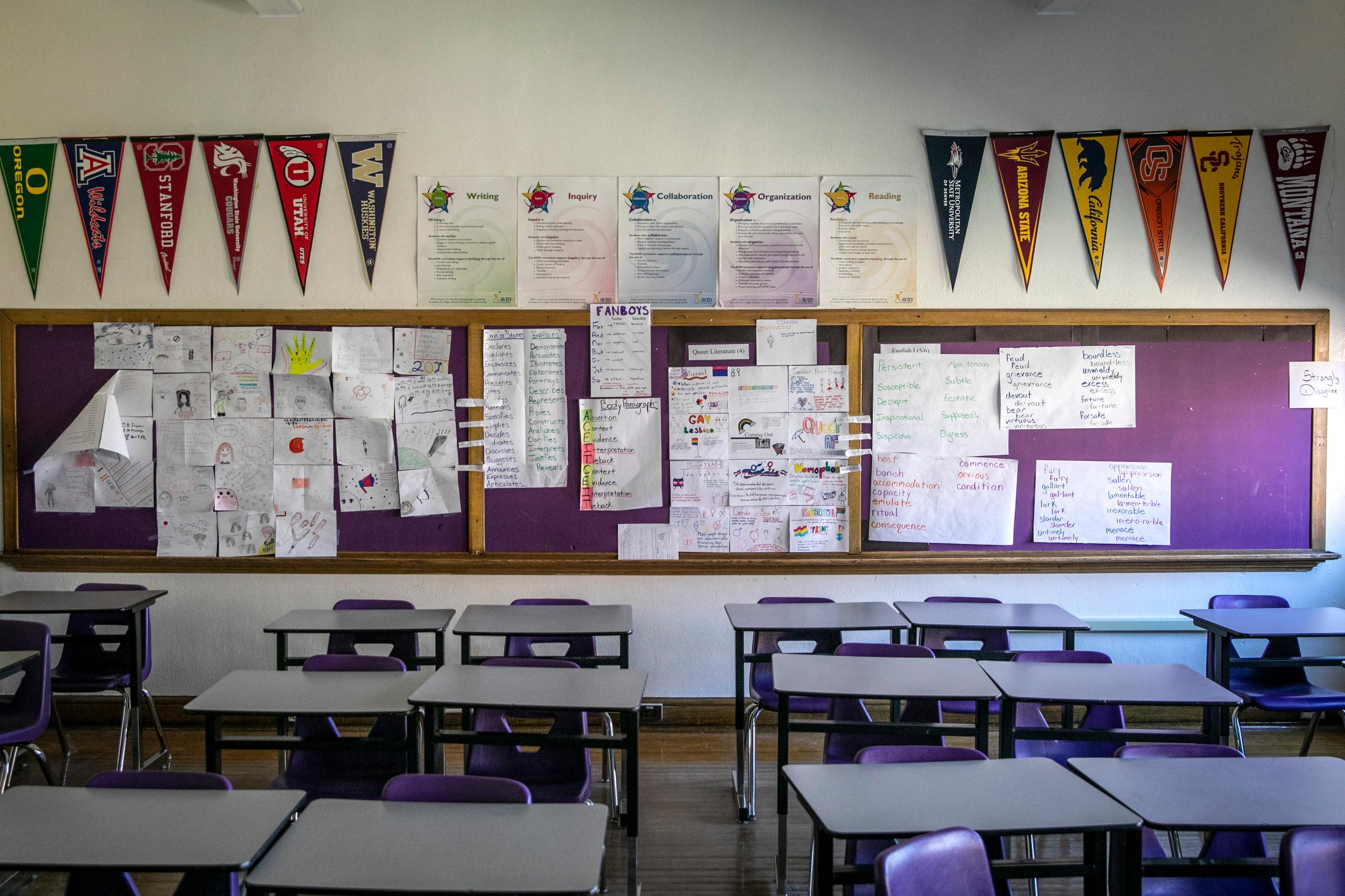
Colorado’s high school graduation rate inched up in 2024 to the state’s highest level in more than a decade. Student dropout rates are also declining but large differences between student groups persist, according to new data from the Colorado Department of Education.
The state’s four-year graduation rate improved 1.1 points to 84.2 percent for class of 2024, while the drop-out rate decreased by 0.2 points to 1.9 percent. A total of 58,318 Colorado students earned their high school diploma in 2024 — about 1,500 more than the prior year. Across Colorado, two-thirds of districts improved or stayed the same in their four-year graduation rate.
“While we are seeing promising progress, we are continuing to see our students of color and our students with the highest needs graduating below our statewide rates,” said Education Commissioner Susana Córdova.
She said, however, that she is encouraged by multiyear improvements and in some gaps that are closing.
Graduation rates also improved for classes of students who take five or six years to graduate. But the seven-year rates remained lower, which officials attribute to challenges faced by students who were juniors when the pandemic began.
Another factor that could be at play is that Colorado expanded the ways students could graduate in 2021-22. The new graduation guidelines consist of a menu of 11 options to show “college and career readiness” without having to meet a minimum score on the college entrance exams, the SAT. The state has become a pioneer in recognizing that thousands of students are not interested in obtaining a four-year college degree and are also opening up other ways for students to show they’re ready for life after high school.
As alternatives to using SAT scores for high school graduation, students can use industry certifications, a test that helps determine a student’s eligibility for a career in the military, a capstone project, or International Baccalaureate exam scores, among others.
The top three ways Colorado students are demonstrating that they are ready for graduation are via the SAT, enrolling in college classes, and a final capstone project.
“It's (a capstone project) aligned to the skills that are required both for academic purposes but also for work-based purposes,” said Córdova.
Superintendent Deirdre Pilch of the Greeley Evans school district said new graduation requirements doesn’t mean students are less ready academically.
“We have seen a 50 percent decrease in the numbers of students who have to take remedial coursework when they get to college, and so that's been a real win for us, and that tells us that our students are readier for college than what they were a couple of years ago.”
Gaps across student groups
Four-year graduation rates increased for Hispanic (up 1.2 percentage points), American-Indian/Alaska Native (up 1.9 percentage points), and multiracial students (up 1.5 percentage points) above the statewide increase of 1.1 percentage points. However, their overall rates of graduation still lag behind the state average rate. The percentage of African American and Hawaiian/Pacific Islander students who graduated in four years decreased slightly.
The student groups showing the most improvement in the four-year rate were students experiencing homelessness (up 3.6 percentage points) and students in foster care (up 4.2 percentage points.) Their rates of graduating in four years, however, lag overall state numbers.
The graduation rate for girls was 86.6 percent, 4.8 points higher than the rate for boys. The graduation rate for students who identify as non-binary was 90 percent but that group comprised only 70 students.
Pilch said in focus groups, male students said they leave high school to work to help support their families. The district has responded by shifting one of the alternative schools to a four-day week to allow students to work a full Friday, Saturday and Sunday.
Englewood Superintendent Joanna Polzin said the district’s biomedical and engineering pathways have attracted more male students.
“There’s high interest for them and that’s something that's keeping our kids in school as well.”
Dropout rates
Last school year, Colorado’s dropout rate decreased by 0.2 points to 1.9 percent, meaning 8,947 students in grades 7-12 dropped out — that’s down 718 students compared to 2023.
The dropout rate is down from 2.2 percent during the pandemic in 2021-2022 and is close to the state’s historic low of 1.8 percent in 2019-2020 and 2020-2021 school years. But, drop-out rates for most students of color remain higher than for the state as a whole.
Individual school districts
Most school districts saw their graduation rates increase slightly, but the biggest jumps in big districts were in Commerce City’s Adams 14 (up 7.1 percentage points), Pueblo 60 (up 4.4 percentage points), and Greeley-Evans 6 (up 3.6 percentage points).
In rural districts, Delta saw a 9.8 percent increase, Fort Morgan saw a 6.0 percent increase and Ignaciao increased 11.6 percent.
“We are educating our children out of poverty”
Officials in the Greeley-Evans school district put a strong emphasis on ninth grade, starting with a summer transition program that pairs cohorts of students with a teacher. Every student has a graduation plan and mentors and coaches make sure students are on track.
“We support students at our schools with credit gaps through credit recovery and tutoring because on-time graduation is our number one goal,” said assistant superintendent Anthony Asmus.
The district partners with the organization Zero Dropouts to offer a GED option and programs for students who need more than four years to graduate.
The Greeley-Evans district has been intentionally increasing the number of school clubs and activities such that 75 percent of high school students are engaged in at least one activity. It offers 29 career pathways and more than 2,000 students will graduate with college credit on their transcript when they leave high school.
“We are educating our children out of poverty,” said Pilch.
Eighty-six percent of Hispanic students graduated on time last year, almost 10 points higher than the statewide rate.
Ignacio Superintendent Chris deKay says the key to improving graduation rates in his district has been partnerships with the Southern Ute tribe to support Native American students, safety nets for struggling students, an expert who trains teachers on strategies to engage students, and a partnership with other rural schools.
“We send teachers out to other rural schools and they send teachers and leaders into our school, and we get feedback from them on how to improve our system, and we and in turn we give them feedback on how to improve their districts.”
The district has also worked hard to retain teachers by approving a significant salary increase and offering more professional development opportunities.
Half of Ignacio’s graduates head straight into the workforce so an emphasis on career and technical programs such as agriculture, welding, building trades, business, and family and consumer science give students the skills they need.
Relationship-based environment
State officials also praised the efforts of the Englewood School District in lowering dropout rates by 2 percentage points.
Superintendent Polzin said the district’s alternative high school, Colorado’s Finest High School of Choice, which draws students from across the metro area, has one of the lowest drop out rates among alternative schools at 5.9 percent.
“When students experience a relationship-based environment and innovative instructional techniques, they find a sense of belonging,” she said.
The district places emphasis on tapping into students’ interests and passions at a young age to keep them engaged in school. It partners with the Center for High School Success to support ninth-graders staying on track, ensures its students have an advisory or “family class” and an advocate who builds a strong relationship with the student. Using a state-funded counselor corps grant, the district has launched a new initiative that combines social and emotional learning with individual career and academic planning in all grades.
“We do this because we recognize the importance of meeting the needs of the whole child,” said secondary success director Diana Zakhem.
The district also partners with Colorado Youth for a Change and AmeriCorps for attendance and academic support for students who need it, a credit recovery program during the academic year and summer, and family support for students who are chronically absent.









